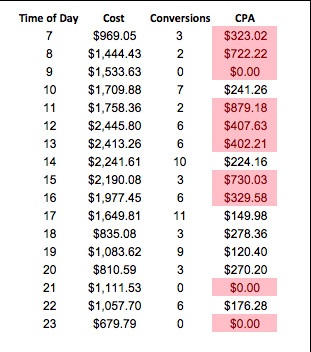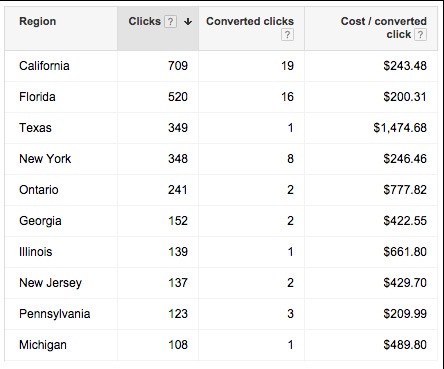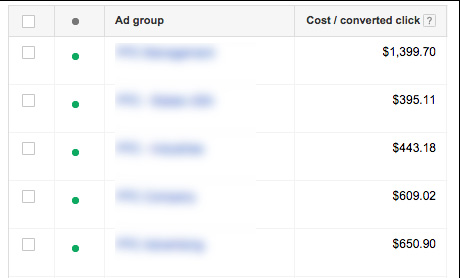[display-name-category]
[post_author]
I’m a big fan of e-commerce campaigns. Especially products that lie in the mid-tier price range. You get a lot of conversions, so you  have plenty of data to work with, but you also have sufficient revenue to test and be sustainable.
have plenty of data to work with, but you also have sufficient revenue to test and be sustainable.
However, marketing managers for e-commerce stores often mistake the reasons why they work for an e-commerce store with the capabilities of Google AdWords. Just because you’re selling to the entire US, then it doesn’t have to mean you should use AdWords to advertise to everyone.
In today’s blog post, I want to highlight 7 typical mistakes that I often find in e-commerce campaigns.
1) Missing The Value of Selecting Brand Keywords For The Products You Sell
In her amazing book The Strategist, Cynthia Montgomery gives several examples of businesses that had all the right skills to succeed. However, they were competing in markets that either had very low margins across the board or had other fundamentals that were making it an impossible quest.
The same can be said about selecting your keywords in Google AdWords. One of the biggest mistakes that I see e-commerce stores make in their AdWords campaigns is their lack of consideration for the customer intent behind the keyword they’re using. It sounds like a complicated thing, but it isn’t. Let me give you an example of a recent buying funnel analysis we made:
1) Running Shoes = Consumer is thinking “Hey, I need running shoes. What is out there?”
2) Best running shoes for flat feet = Consumer: “I have flat feet, my knees hurt, what’s best? Oh, Nike is best? Great!”
3) Nike Running Shoes = Consumer: “What does Nike have to offer my flat feet?”
4) Nike Free 5.0 Running shoes = Consumer: “I really like the style of the Free 5.0. What else do they have?”
5) Cheapest Nike Free 5.0 Running Shoes = Consumer: “Yup. I’m getting Nike Free 5.0. Are they cheaper anywhere?”
6) Nike Free 5.0 Running Shoe Coupons = Consumer: “One last try. Can I get them cheaper?”
There are a couple of more nuances in this, but as a whole, the journey above will give you a good picture of why branded keywords convert better than generic keywords. Generic keywords (i.e. running shoes) are usually used very early in the buying funnel while branded keywords represent consumers who are more aware of what they want.
It’s inaccurate to make such general assumptions as I’ve made above. It’s never this simple, but if you start with branded keywords, you’re more likely to have a profitable campaign. Start where you can get the biggest bang for your buck and work yourself up from there.
2) Thinking That Google Shopping is a Set and Forget Campaign
Google Shopping is one of the absolute best ways for ecommerce stores to advertise. It takes a lot of the regular tasks associated with AdWords Search campaigns away. You don’t need to optimize ad text, keyword selection, or any of the other facets that you normally focus on.
But it’s not set-and-forget.
Let me repeat. You can’t just set it up and forget about it.
A new guy in PPC, Andreas Reiffen, posted some advanced tactics for optimizing Google Shopping campaigns. If you go through some of the tactics he mentions, you’ll see why Google Shopping is far from a set-and-forget campaign type.
Areas to Optimize With Google Shopping
-
Bid and budget management
-
Negative Keyword (review your search terms for irrelevant search terms)
-
Product grouping: Products must be grouped in such a way that bidding can be optimized
-
Data Feed: Your data feed is like your keywords and ads wrapped into one. Don’t ignore it
You can read more about Google Shopping Optimization here:
- 9 Tactic for Efficient Google Shopping Feed Optimization
- Is Your Google Shopping Listing as Optimized as it Could Be?
3) Not Reviewing Ad Scheduling (You Can Buy Products from me Anytime!)
A big reason e-commerce is more interesting than owning a retail store is that you can sell to anyone anytime. Even though that’s true, then consumers will not have the same buying tendencies throughout the day.
For some products, you research during the day and buy in the evening at home. Others research and buy no matter the time of day (or if they’re at their job).
I’ve seen huge changes in how well campaigns perform depending on what time of day it is. You should always review your ad scheduling for ways to improve the profitability of your AdWords campaigns:

In the example above (taken from a campaign before it was optimized), the variation in CPA depending on what time of day it is. The trend for this particular campaign is that morning time isn’t as heavy on conversions as the afternoon/evening.
Knowing this, we can better put our budget to use and stay profitable.
4) Not Optimizing Your Geographical Targeting (You Can Buy Products from me Anywhere!)
The example I gave you above also applies to geographical targeting. Just because you ship to the entire continental US, it doesn’t mean you should advertise everywhere.
You will without a doubt experience that some states convert at a higher CPA than others. Not checking your location settings and seeing how you convert in the areas that you are targeting means you’re missing out on ways to optimize your ad spend.
How to Check:
-
Go to Dimensions
-
Click on Geographic in the dropdown
-
Make sure your columns only include “Region”
-
If you segment further than the region, you’ll get data per metro area, which will make it hard for you to gather any real insights (unless you’re an Excel star).

Particularly True for New Ecommerce Campaigns
This is one of the top mistakes I see from brand new e-commerce campaigns. The failure to research the shipping prices to at least all states and proactively see how much the difference it can cost you a lot of money. If you for instance quickly realize that it’s 50% more expensive to ship across the country than it is to your immediate surrounding states, focus on these states instead of casting a wide net.
Not only will your campaigns be more profitable, but you can also outperform your competitors from across the coast on shipping time and price.
5) Relying Too Heavily On The Core of AdWords Instead of Experimenting With New Features
Managing AdWords campaigns for e-commerce stores have quickly been turned on its head. No longer is it about whether you can just create successful Search campaigns by choosing the right keywords and ad copy.
No, you have to keep up with remarketing for search, Google Shopping, Dynamic Display Remarketing, ad extensions, and many more if you want to compete. The biggest trend I see in new advertisers coming to White Shark Media is their comments around performance:
I was doing very well with AdWords back in 2010-2012, but in the last couple of years my cost per conversion has increased and the number of conversions gone down.
When analyzing these accounts the truth is almost always the same: A failure in pursuing the newest features in Google AdWords. We have already covered Google Shopping, but the other two very big areas that you need to be invested in are:
Both areas have shown incredible results for the e-commerce campaigns I manage. In most cases, these campaign types outperform my regular search campaigns with a 2-1 or 3-1 margin while still bringing in considerable revenue.
6) Relying on CPA to Determine Campaign Profitability
Back in 2013, I wrote about how the CPA should be retired. I still believe this is true for ecommerce stores. You’re not selling a single product with no cost fluctuations. Even if you did, you’re not selling the same quantities all the time.
A very clear example is the two keywords:
-
Nike running shoes in bulk
-
Nike running shoes for kids
We can all agree that the outcome of conversion for these two keywords will result in different revenue.
So why give both keyword types the same CPA goal?
Especially when we can easily get the actual dollar value from each transaction and optimized based on this.
My recommendation is that instead of working with a CPA goal, work with ROI/ROAS metrics. This will be far more useful for you. I recommend reading my blog post about the subject as it will give much more insights into how you can use the revenue to guide your optimizations instead of conversions:
7) Only Reviewing The Top Level Numbers When Optimizing
If there is one thing that I always see that advertisers make mistakes with, then it’s only relying on top-level numbers. To be honest, that’s why many AdWords agencies can provide free evaluations and always find mistakes.
Most advertisers don’t dig deep enough.
Here is a real-life example from a campaign I’m working on right now:
Account Level CPA = $330
Overall on the account, the cost per conversion is $330.
Individual Campaign Level = 4 campaigns with CPAs above $700
When I look at each campaign, I find 4 campaigns where the cost per conversion for the entire campaign is above $700.
These campaigns need to be optimized because whenever we have a sale at above $400, we lose money.
One campaign below the $330 CPA average = Found 4 ad groups with CPAs over $600
Furthermore, I then take a deep dive look into my top campaign that’s below the $330 cost per conversion average. Inside this, I find 4 ad groups that have CPAs above $600:

If I had just taken a quick glance at the account, I would have been able to say that we were doing just fine, and there was no need to optimize the account. However, digging deeper revealed several areas of opportunity that I couldn’t see.
Pro Tip: If you’re with an agency you need to do the same deep dive. I often see agencies including their client’s brand name (i.e. White Shark Media, Amazon, Google) in their regular campaigns. Seeing that your brand name will convert a lot better than any other keyword, this helps boost their overall campaign numbers and hide possible poor performance. Taking a deep dive into your account can fix this.
The Most Important Mistake You Have To Fix?
When working with AdWords there are always areas to optimize, but working on the areas that matter the most is by far the most valuable choice you can make.
If there is one thing that you should walk away from when reading this blog post it is that you should start working with remarketing.
Remarketing for search can increase your ROI 2-3 times on the same keywords you’re using today. Display Remarketing can increase your generated revenue by 10-30% with even better ROI than you have today.
Don’t let such opportunities slip by you. Start working with remarketing today.






